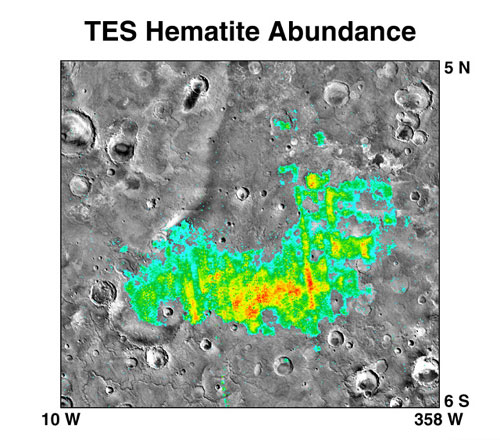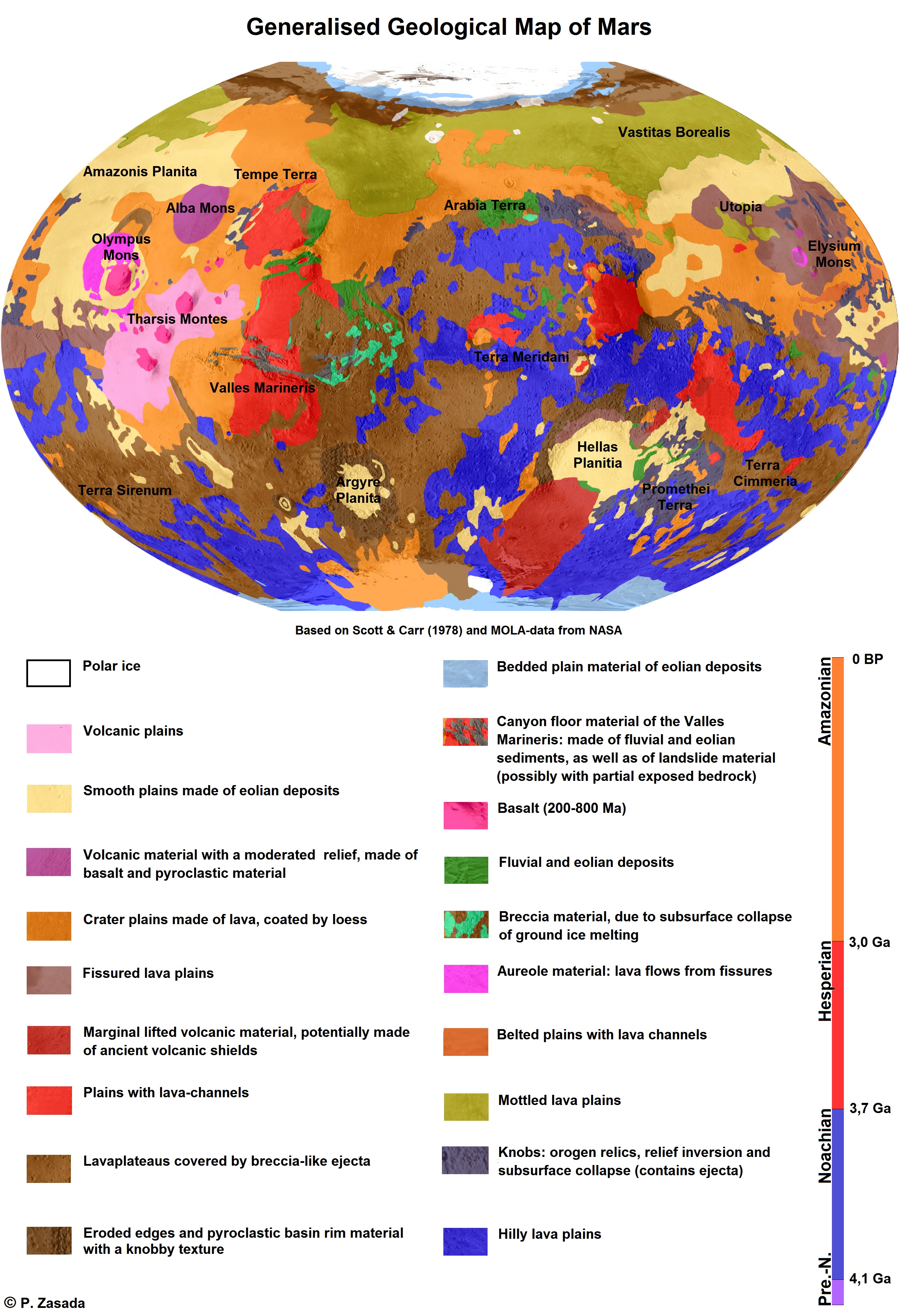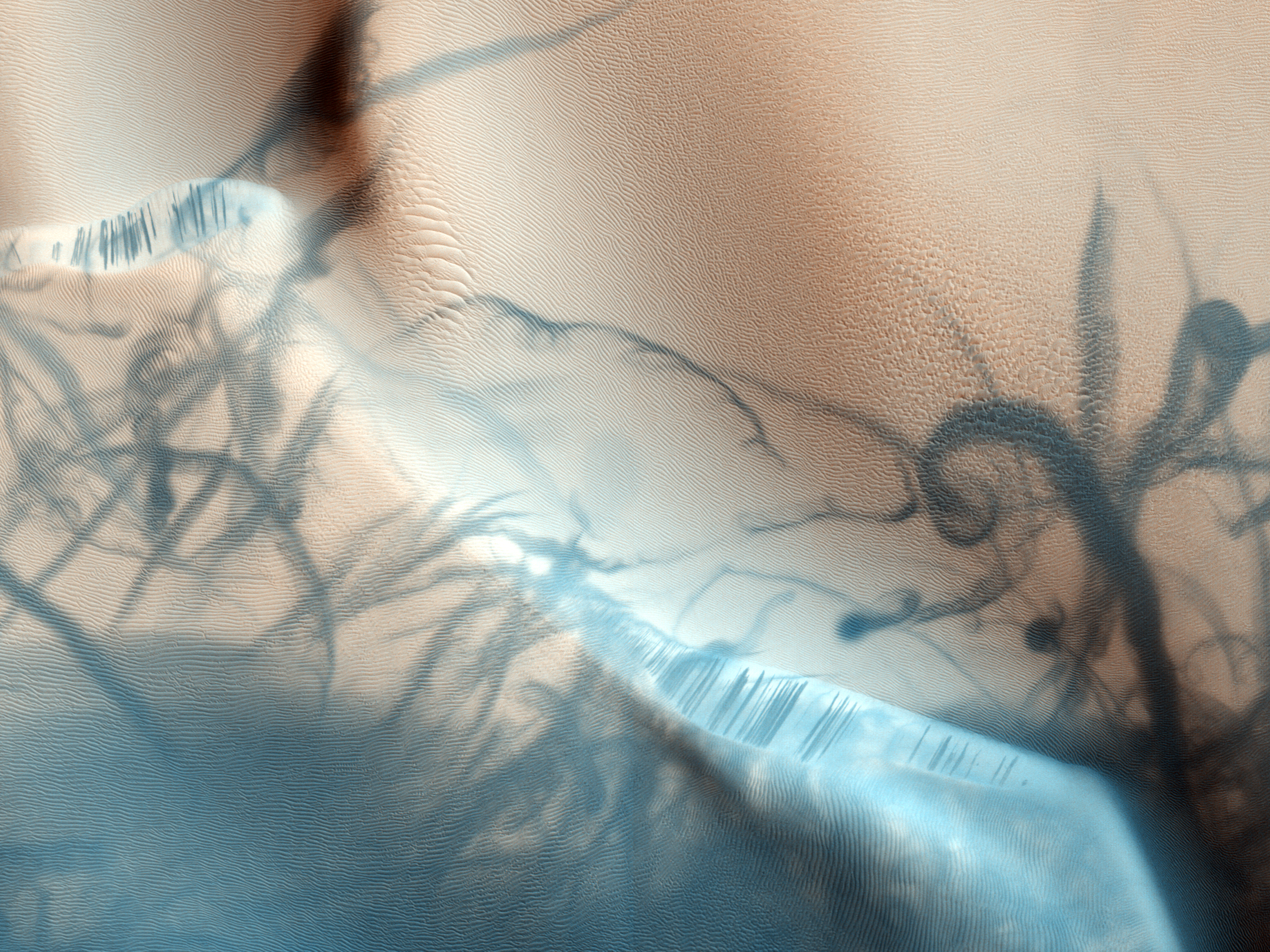|
Sirenum Fossae
Sirenum Fossae is a long trough in several quadrangles including Memnonia quadrangle and Phaethontis quadrangle of Mars, centered at 35.57° south latitude and 197.26° west longitude. Sirenum Fossae is 2,735 km long and was named after a classical albedo feature name. Troughs on Mars like this one are called Fossae. Sirenum Fossae is believed to have formed by movement along a pair of faults causing a center section to drop down. This kind of feature is called a graben. Mapmariner.jpg, Map showing relative positions of Sirenum Fossae, Atlantis Chaos, Gorgonum Chaos, Magelhaens Crater and Simois Colles Gullies The pictures below show gullies in Sirenum Fossae. Gullies occur on steep slopes, especially on the walls of craters. Gullies are believed to be relatively young because they have few, if any craters. Moreover, they lie on top of sand dunes which themselves are considered to be quite young. Usually, each gully has an alcove, channel, and apron. Some stud ... [...More Info...] [...Related Items...] OR: [Wikipedia] [Google] [Baidu] |
Thermal Emission Imaging System
The Thermal Emission Imaging System (THEMIS) is a camera on board the 2001 Mars Odyssey orbiter. It images Mars in the visible and infrared parts of the electromagnetic spectrum in order to determine the thermal properties of the surface and to refine the distribution of minerals on the surface of Mars as determined by the Thermal Emission Spectrometer (TES). Additionally, it helps scientists to understand how the mineralogy of Mars relates to its landforms, and it can be used to search for thermal hotspots in the Martian subsurface. THEMIS is managed from the Mars Space Flight Facility at Arizona State University and was built by the Santa Barbara Remote Sensing division of Raytheon Technologies Corporation, an American multinational conglomerate headquartered in Waltham, Massachusetts. The instrument is named after Themis, the goddess of justice in ancient Greek mythology. Infrared camera THEMIS detects thermal infrared energy emitted by the Martian surface at nin ... [...More Info...] [...Related Items...] OR: [Wikipedia] [Google] [Baidu] |
Magelhaens (Martian Crater)
Magelhaens is the name used by the International Astronomical Union for features commemorating the explorer Ferdinand Magellan. It can refer to: * Magelhaens (lunar crater) Magelhaens is a lunar impact crater that lies along the southwestern edge of the Mare Fecunditatis, in the eastern part of the Moon's near side. It was named after 16th-century Portuguese explorer Ferdinand Magellan. It lies to the south-south ..., a feature on the Moon * Magelhaens A, an associated feature on the Moon * Magelhaens (Martian crater), a feature on Mars {{disambiguation ... [...More Info...] [...Related Items...] OR: [Wikipedia] [Google] [Baidu] |
Mars Orbiter Laser Altimeter
260px, MOLA topographic images of the two hemispheres of Mars. This image appeared on the cover of ''Science'' magazine in May 1999. The Mars Orbiter Laser Altimeter (MOLA) was one of five instruments on the '' Mars Global Surveyor'' (MGS) spacecraft, which operated in Mars orbit from September 1997 to November 2006. However, the MOLA instrument transmitted altimetry data only until June 2001. The MOLA instrument transmitted infrared laser pulses towards Mars at a rate of 10 times per second, and measured the time of flight to determine the range (distance) of the MGS spacecraft to the Martian surface. The range measurements resulted in precise topographic maps of Mars. The precision maps are applicable to studies in geophysics, geology and atmospheric circulation. MOLA also functioned as a passive radiometer, and measured the radiance of the surface of Mars at 1064 nanometers. Planetary laser altimetry A laser altimeter is an instrument that measures the distance from an ... [...More Info...] [...Related Items...] OR: [Wikipedia] [Google] [Baidu] |
Martian Gullies
Martian gullies are small, incised networks of narrow channels and their associated downslope sediment deposits, found on the planet of Mars. They are named for their resemblance to terrestrial gullies. First discovered on images from Mars Global Surveyor, they occur on steep slopes, especially on the walls of craters. Usually, each gully has a dendritic ''alcove'' at its head, a fan-shaped ''apron'' at its base, and a single thread of incised ''channel'' linking the two, giving the whole gully an hourglass shape. They are estimated to be relatively young because they have few, if any craters. A subclass of gullies is also found cut into the faces of sand dunes, that are themselves considered to be quite young. Linear dune gullies are now considered recurrent seasonal features. Most gullies occur 30 degrees poleward in each hemisphere, with greater numbers in the southern hemisphere. Some studies have found that gullies occur on slopes that face all directions; others have found ... [...More Info...] [...Related Items...] OR: [Wikipedia] [Google] [Baidu] |
Geology Of Mars
The geology of Mars is the scientific study of the surface, crust, and interior of the planet Mars. It emphasizes the composition, structure, history, and physical processes that shape the planet. It is analogous to the field of terrestrial geology. In planetary science, the term ''geology'' is used in its broadest sense to mean the study of the solid parts of planets and moons. The term incorporates aspects of geophysics, geochemistry, mineralogy, geodesy, and cartography. A neologism, areology, from the Greek word ''Arēs'' (Mars), sometimes appears as a synonym for Mars's geology in the popular media and works of science fiction (e.g. Kim Stanley Robinson, Kim Stanley Robinson's Mars trilogy). The term areology is also used by the Areological Society. Geological map of Mars (2014) File:Geologic Map of Mars figure2.pdf, Figure 2 for the geologic map of Mars Global Martian topography and large-scale features Composition of Mars Mars is a terrestrial planet, which ... [...More Info...] [...Related Items...] OR: [Wikipedia] [Google] [Baidu] |
HiWish Program
HiWish is a program created by NASA so that anyone can suggest a place for the HiRISE camera on the Mars Reconnaissance Orbiter to photograph. It was started in January 2010. In the first few months of the program 3000 people signed up to use HiRISE. The first images were released in April 2010. Over 12,000 suggestions were made by the public; suggestions were made for targets in each of the 30 quadrangles of Mars. Selected images released were used for three talks at the 16th Annual International Mars Society Convention. Below are some of the over 4,224 images that have been released from the HiWish program as of March 2016. Glacial features Some landscapes look just like glaciers moving out of mountain valleys on Earth. Some have a hollowed-out appearance, looking like a glacier after almost all the ice has disappeared. What is left are the moraines—the dirt and debris carried by the glacier. The center is hollowed out because the ice is mostly gone. These supposed alp ... [...More Info...] [...Related Items...] OR: [Wikipedia] [Google] [Baidu] |
HiRISE
High Resolution Imaging Science Experiment is a camera on board the ''Mars Reconnaissance Orbiter'' which has been orbiting and studying Mars since 2006. The 65 kg (143 lb), US$40 million instrument was built under the direction of the University of Arizona's Lunar and Planetary Laboratory by Ball Aerospace & Technologies Corp. It consists of a 0.5m (19.7 in) aperture reflecting telescope, the largest so far of any deep space mission, which allows it to take pictures of Mars with resolutions of 0.3m/pixel (1ft/pixel), resolving objects below a meter across. HiRISE has imaged Mars exploration rovers on the surface, including the ''Opportunity'' rover and the ongoing ''Curiosity'' mission. History In the late 1980s, of Ball Aerospace & Technologies began planning the kind of high-resolution imaging needed to support sample return and surface exploration of Mars. In early 2001 he teamed up with Alfred McEwen of the University of Arizona to propose such ... [...More Info...] [...Related Items...] OR: [Wikipedia] [Google] [Baidu] |
Dry Ice
Dry ice is the solid form of carbon dioxide. It is commonly used for temporary refrigeration as CO2 does not have a liquid state at normal atmospheric pressure and sublimates directly from the solid state to the gas state. It is used primarily as a cooling agent, but is also used in fog machines at theatres for dramatic effects. Its advantages include lower temperature than that of water ice and not leaving any residue (other than incidental frost from moisture in the atmosphere). It is useful for preserving frozen foods (such as ice cream) where mechanical cooling is unavailable. Dry ice sublimates at at Earth atmospheric pressure. This extreme cold makes the solid dangerous to handle without protection from frostbite injury. While generally not very toxic, the outgassing from it can cause hypercapnia (abnormally elevated carbon dioxide levels in the blood) due to buildup in confined locations. Properties Dry ice is the solid form of carbon dioxide (CO2), a molecul ... [...More Info...] [...Related Items...] OR: [Wikipedia] [Google] [Baidu] |
Simois Colles
Simois Colles is a region of colles (hills) in the northwest of Phaethontis quadrangle of Mars. It is located around 37.72° south latitude, and 176.59° west longitude. The region is across, and was named after an albedo feature An albedo feature is a large area on the surface of a planet (or other Solar System body) which shows a contrast in brightness or darkness (albedo) with adjacent areas. Historically, albedo features were the first (and usually only) features to b .... References External links * Phaethontis quadrangle {{Mars-stub ... [...More Info...] [...Related Items...] OR: [Wikipedia] [Google] [Baidu] |
Gorgonum Chaos
Gorgonum Chaos is a set of canyons in the Phaethontis quadrangle of Mars. It is located at 37.5° south latitude and 170.9° west longitude. Its name comes from an albedo feature at 24S, 154W. Some of the first gullies on Mars were found in Gorgonum Chaos. It is generally believed that it once contained a lake. Other nearby features are Sirenum Fossae, Maadim Vallis, Ariadnes Colles, and Atlantis Chaos. Some of the surfaces in the region are formed from the Electris deposits. Mapmariner.jpg, Map showing relative positions of Gorgonum Chaos, Atlantis Chaos, Magelhaens Crater and Simois Colles Gullies Gullies on Mars may be due to recent flowing water. Many are present in the Gorgonum Chaos. Gullies occur on steep slopes, especially craters. Gullies are believed to be relatively young because they have few, if any craters, and they lie on top of sand dunes which are young. Usually, each gully has an alcove, channel, and apron. Although many ideas have been put forward to ex ... [...More Info...] [...Related Items...] OR: [Wikipedia] [Google] [Baidu] |
Trough (geology)
In geology, a trough is a linear structural depression that extends laterally over a distance. Although it is less steep than a trench, a trough can be a narrow basin or a geologic rift. These features often form at the rim of tectonic plates. There are various oceanic troughs on the ocean floors. Examples of oceanic troughs * Benue Trough * Cayman Trough * Kings Trough * Hesperides Trough * Nankai Trough * Northumberland Trough * Okinawa Trough in the East China Sea * Rockall Trough and others along the rift of the mid-oceanic ridge A mid-ocean ridge (MOR) is a seafloor mountain system formed by plate tectonics. It typically has a depth of about and rises about above the deepest portion of an ocean basin. This feature is where seafloor spreading takes place along a diverge ... * Salton Trough * South Shetland Trough * Suakin TroughDinwiddie, Robert et al. (2008) ''Ocean: The World's Last Wilderness Revealed'', London, Dorling Kindersley, page 452. in the Red Sea ... [...More Info...] [...Related Items...] OR: [Wikipedia] [Google] [Baidu] |
Atlantis Chaos
Atlantis Chaos is a region of chaos terrain in the Phaethontis quadrangle of Mars. It is located around 34.7° south latitude, and 177.6° west longitude. It is encompassed by the Atlantis basin. The region is across, and was named after an albedo feature at 30° S, 173° W. Mapmariner.jpg, Map showing relative positions of Atlantis Chaos, Gorgonum Chaos, Magelhaens Crater and Simois Colles See also * List of areas of chaos terrain on Mars This is a list of areas of chaos terrain officially named by the International Astronomical Union on the planet Mars. Chaos terrain (or chaotic terrain) is an astrogeological term used to denote planetary surface areas where features such as rid ... References External links Phaethontis quadrangle Chaotic terrains on Mars {{Mars-stub ... [...More Info...] [...Related Items...] OR: [Wikipedia] [Google] [Baidu] |







